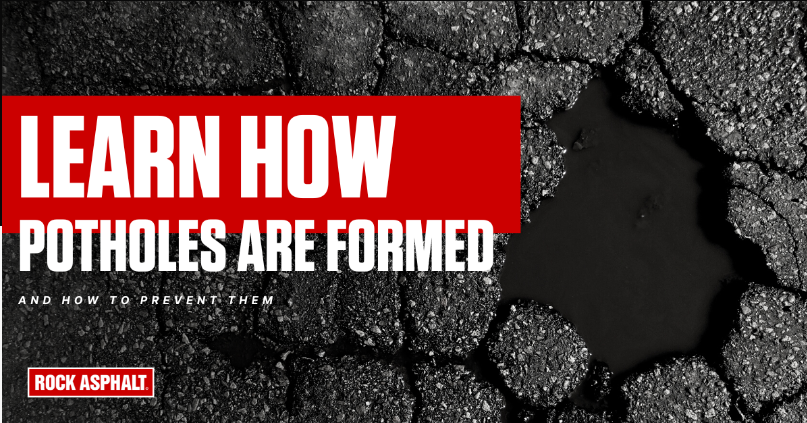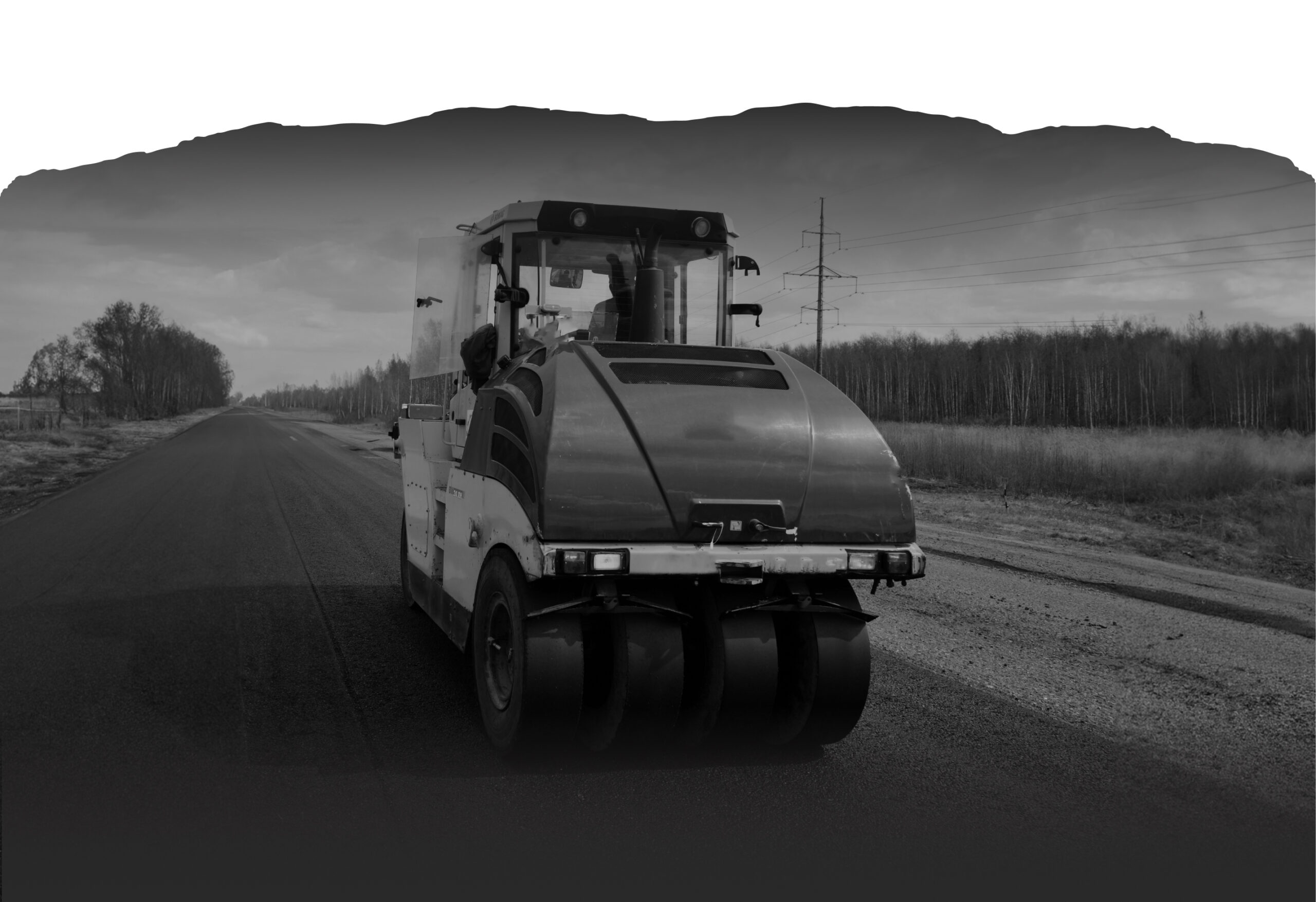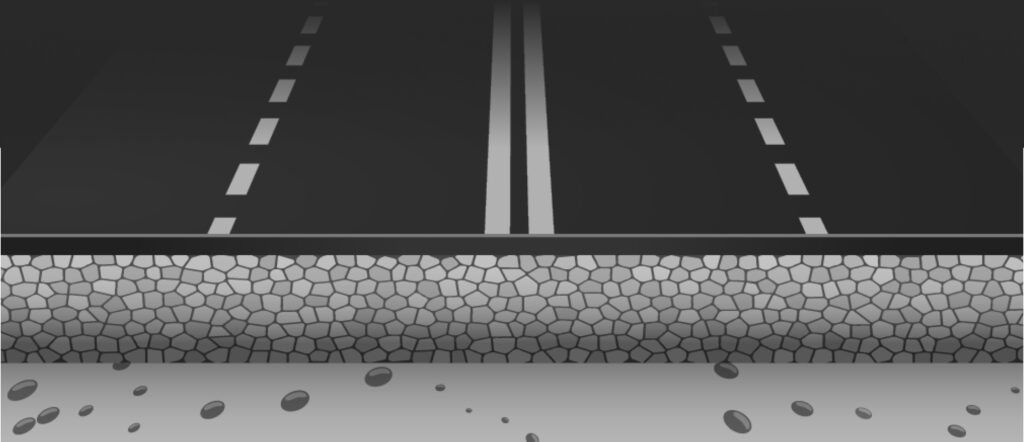How Are Potholes Formed?

How are potholes formed? We all know what a pothole is because most of us have probably spent a few hours at a tire shop after driving over one. At their best, potholes are a $300 nuisance. At their worst, potholes are extreme liabilities that cause unnecessary risks for municipalities and organizations responsible for road maintenance.
So what causes potholes to appear and why do these small holes become big issues? To answer these questions we’ll look at how potholes are formed, how they’re repaired, potential hazards, and how to proactively prevent potholes on your roads with RockAsphalt©.
How Are Potholes Formed? 2 Main Causes
There are two major factors that cause a pothole to form: traffic and weather.
When a road is first paved, it has a one to two foot rock base topped with a layer of asphalt. When the base is level, you can get many years of use out of this pavement. However, weather and heavy traffic can cause this top layer of asphalt to deteriorate at an accelerated pace.
Potholes occur when there are cracks in the asphalt, allowing water to penetrate the base. Once that happens, the water can freeze and then heat up, creating steam. Small holes and cracks become more extensive and eventually penetrate the base. This process continuously deteriorates the road more and more.
While moisture deteriorates the material beneath the surface, the weight of vehicles creates added pressure on the top layer of asphalt. The heavy weight of traffic eventually causes the top layer of asphalt to cave, forming a pothole.
This process becomes even worse between winter and spring when the temperature frequently fluctuates above and below the freezing point. Because of this, more potholes form faster in the early months of the year, dubbing this time of the year, “pothole season.”
How Often Are Potholes Repaired?
When it comes to repairing a pothole, there are many factors that need to be considered. First, the surface type and frequency of traffic will dictate how long the street lasts before being redone.
Residential roads can last between 20-30 years with regular maintenance; occasional resurfacing doubles or triples this estimate! This means residential areas are less likely to experience premature wear because most vehicles only carry passengers and small cargo rather than heavy commercial loads.
Highways and Interstates experience the most accelerated wear of any surface type – but this is especially true for roads where heavy trucks are prone to constant start and stop traffic. The top layer may only get resurfaced every 8-10 years; however, some will become damaged sooner in areas of high heat and humidity.
The material used to repair potholes depends on multiple factors as well, especially weather. During warmer temperatures, organizations are able to use hot mix asphalt to permanently patch potholes. However, during “pothole season” when temperatures are too low for hot mix, cold patch asphalt is the normal alternative.
While cold patch asphalt is capable of temporarily fixing damaged pavement, most repairs will eventually fail and must be replaced within the year. This is because many cold patches are considered temporary asphalt patches and not permanent repairs.
Problems Caused By Potholes
Potholes tend to form at common stand or stop areas. Each pothole, when left unrepaired, can continue to deteriorate the road resulting in significant damage. When left unrepaired, a pothole’s damage can end up impacting the entire road costing cities millions every year.
On average, American drivers spend over 3 billion dollars annually on vehicle damage caused by potholes. However, potholes pose a much more dangerous threat than the cost of a new tire.
Large enough potholes can cause major traffic closures and traffic accidents. Organizations responsible for road maintenance are often liable for the damage caused by unmaintained roads.
As more and more of the underlying base layer of material is affected, added pressure also causes “alligatoring” to the surrounding asphalt. These interconnecting cracks spread towards any part of the pavement with a weakened base.
If left unattended for too long, extensive alligatoring requires complete reconstruction of the pavement for structural integrity. Asphalt crack filler is a potential solution if the alligatoring is caught early enough.
In extreme cases of water washing away the base material beneath a road, unmaintained roads can develop “sinkholes”, capable of swallowing entire cars, requiring complete road reconstruction, and can result in legal liabilities.
2 Causes of Potholes, 1 Solution
While a 6 foot deep sinkhole is one of the most extreme examples of what traffic and weather can do to a road, it’s not uncommon for even the smallest of potholes to cause big problems.
Public works departments work tirelessly to maintain their roads, but as this article has discussed, potholes can form anywhere, anytime. Too often, a pothole is only reported long after it’s been a problem.
Hot mix is a great material for patching potholes of any size, but the preparation of the material, curing time, and weather restraints make using this product a limited and cumbersome option. Cold patch asphalt generally only offers temporary repairs, forcing organizations to revisit failed patches time and time again.
With RockAsphalt©, organizations are able to save time and money by making proactive pothole repairs simply and permanently. That’s because RockAsphalt© has the unique ability to tackle the two root causes of potholes better than manufactured mixes.
Traffic
The pressure caused by traffic is one of the biggest contributors to pothole formation. RockAsphalt© creates a permanent bond on compaction, meaning your repairs are ready for heavy traffic immediately.
When a dangerous pothole is reported on a busy intersection, time can be of the essence for repairs. Manufactured mixes like hot and cold mix asphalt have varying cure times where the patch is still vulnerable to failing.
Even many “traffic-ready” cold patches must cure for a few hours before the chemical bonders fully harden. It’s during this curing time that traffic is likely to push a patch out of place.
Bonding directly on compaction, using RockAsphalt© as an alternative to cold patch ensures your repairs won’t rut, shove, or migrate, even right after installation.
Weather
Rather than waiting for the weather to use hot mix asphalt, organizations can make permanent repairs in any weather condition without the use of tools or training.
Although made for colder, wetter temperatures, many cold patches tend to fail over time due to changes in ambient temperature that affect cure times. If moisture finds its way into a cold patch while curing, the patch will eventually fail and likely create an even worse pothole.
Once RockAsphalt© is compacted, the unique material forces out all air and moisture, ensuring your repair is sealed, protecting the base layer from external elements.
By tackling “pothole season” with RockAsphalt©, you can make permanent repairs that won’t have to be revisited later in the year with another material.
Proactive Pothole Repair with RockAsphalt©
Potholes are the result of traffic and weather wearing away at asphalt over time. It’s inevitable that potholes form, but paying attention to the root cause of potholes can greatly reduce future risks and liabilities.
So whether you’re trying to avoid a trip to the tire shop or repair Main Street for all the tires, RockAsphalt© is your traffic-ready, weather-resistant asphalt solution.
To see the difference RockAsphalt© can make for your community, contact us today. Free samples are available for cities, counties, school districts, DOT’s, and other qualifying industrial accounts.

Ready to do road repairs the fast & easy way?
RockAsphalt© replaces cold and hot mix making road repair of all sizes fast, clean, simple and permanent the first time.
Try it for yourself and learn why crews love it.
Get your free sample bags and have your team see how fast and easy it is to permanently fix potholes.


